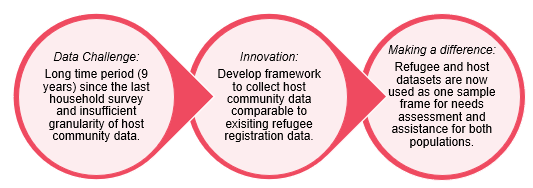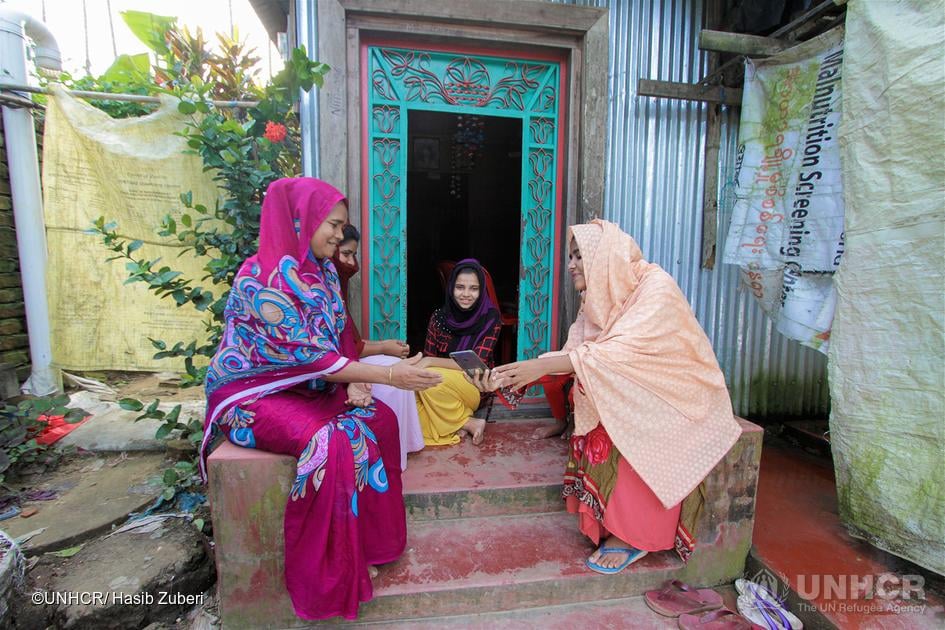By Mohammed Masudur Rahman, Economist, UNHCR, Hussien Ahmad, Information Management Officer, UNHCR
In Cox’s Bazar, where poor Bangladeshis live alongside Rohingya refugees, UNHCR created a new population list with vulnerability data to identify host communities most impacted by the refugee influx. The result is a new set of comparable data on refugees and host communities that is in use today to inform interventions for both communities.
Refugees experience welfare challenges unique to their setting. Forced to flee, they often escape without their assets, identification documents or other personal items without which daily survival is difficult. Once in the host country, many frequently face discriminatory access to social protection often considered de facto for nationals of the hosting countries. Welfare programming for the forcibly displaced therefore requires adapting to the exceptional challenges of the circumstance.
Gathering actionable evidence is key to designing solutions for displaced populations, with the hopes of eventually adapting national social safety nets to also include them. In turn, integrating refugees into wider interventions requires collecting comparable socioeconomic data that can facilitate comparison between the welfare of the displaced and their hosts for the purpose of designing support that address the needs of both populations.
Creating population data for refugees and host communities where none existed
A key consideration in creating comparable refugee and host socioeconomic data is to build a sampling frame that is representative of both populations. Sampling frames determine the particular members who will participate in the data collection survey. As refugees are often outside the scope of national statistics, gauging the right sample frame that enables comparison becomes difficult.
In the context of Bangladesh, over 860,000 Rohingya refugees are living in the world’s largest refugee settlement in Cox’s Bazar. Jointly with the Government of Bangladesh, UNHCR has successfully registered most refugees. The registration exercise, almost equivalent to a census, generated a comprehensive dataset that now serves as a reference for all programmes across the refugee camps.
For the host community, however, there was no such recent dataset with similar detail. Bangladesh’s last national housing and population census was carried out almost a decade ago in 2011. Further, the census generated data disaggregated at the level of the sub-district (known as Upazila), but lacked important details – such as age, gender and disability – at the level of local unions, which are clusters of villages that constitute the country’s lowest administrative unit.
Cox’s Bazar, one of 64 districts and among the poorest nationally, is made up of 8 sub-districts and 71 unions with a 2011 population of 2.3 million persons. As the host community most impacted by the refugee influx is highly concentrated in select unions of Cox’s Bazar, statistics for measuring the welfare of people at the centre of the impact was a challenge. Time passed from the last census and the lack of desired geographical disaggregation in the census data were main factors preventing accurate estimations of welfare.
UNHCR solved this problem by creating a framework for collecting host community data that is similar to the refugee dataset. The framework consists of three main dimensions: household composition information, geotagged location, and vulnerability criteria which includes protection and socioeconomic indicators. This framework was used to collect data on nearly all host community households living in close proximity to UNHCR-managed camps. UNHCR produced a comprehensive geotagged dataset with socioeconomic indicators that is comparable to the refugee data. The geotagging extends up to 7km from the refugee camp boundaries, effectively setting up a baseline for area-based, socially cohesive programming.
These newly created refugee registration and host community datasets are now used as the singular sample frame for all humanitarian and development programmes supporting both populations, including assessment, protection, health, livelihoods, and cash-based interventions. The integrity, comparability and interoperability of the two datasets allow UNHCR and our partners to measure and monitor the impact of the influx and interventions over time. Having such comprehensive and comparable datasets is proving to be especially valuable during the COVID-19 pandemic which has limited door-to-door interactions for the purpose of creating samples and targeting lists.

Innovating to overcome lack of comparable data on Rohingya refugees and host communities living in Cox’s Bazar
While sampling is not the only challenge in gathering data and evidence, it is a fundamental part of the process required to ensure credible and reliable statistics and one of the first considerations that comes up while designing a survey or data collection exercise. In Bangladesh, the absence of an existing national sample frame meant that extensive investments were needed to create the reference list for refugees in the camps.
To ensure that host communities are sufficiently considered in planning and programming processes, these investments were extended to the immediate vicinity of the camps. The solution to overcome lack of data on refugees was borne of a practical need for UNHCR to ensure their protection and for diligent case management; but the benefits, which extend to the host community as well as all humanitarian and development actors participating in the responses, will only become more evident with time.

